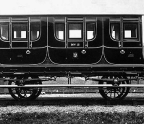BR MOTORAIL TRAINS FORMATIONS AND FINANCES PART ONE

British Railways designed car-carrying services for passengers accompanying their cars on the journey. Starting in the mid-1950s, they ran for 40 years, developing four styles of operation:
Car Sleeper
Car Carrier
Car Tourist
Tail Traffic
Trains ran primarily in the summer months and one set was usually sufficient for each service. Discussion of departure times and frequency (per week) has been avoided, except to clarify workings. Timetables and rationale for terminal selections were reviewed by Faulkner (see references).
Passengers and cars travelled in the same train except for the Car Tourist service where separate trains were used. The latter type was limited to a decade of operation by the Western Region, only to be resurrected by BR in the early 1980s. Car-carriers per se did not carry sleeping cars. Tail traffic usually consisted of car-carrying vehicles attached to ordinary passenger trains, space (berths and/or seats) being reserved within the train for Motorail passengers. These descriptive terms were employed by BR until embraced by the title ‘Motorail’, coined in 1966. For ease of presentation, the word ‘Hybrid’ has been adopted herein to signify a Motorail set combining both car-carrier and overnight car sleeper capabilities. Car-carrying vehicles were usually at the rear of a train, but there were exceptions; in some instances both front and rear positions were obligatory within a single journey.
Various terminal pairings were tried during the years of operation; more than 50 stations were used, including seven in the London area. Some services only survived a couple of seasons, whereas the York-Inverness ran for 25 years. Peak year of Motorail operation was 1972 with 154 departures each week, 26 terminals being active at that time. The largest annual loading was in 1974 with 63,808 cars.
Car sleepers
The Eastern Region introduced the first service in 1955, a car sleeper train running between King’s Cross and Perth. It is not surprising that the Eastern Region was the initiator. The Region’s territory had been part of the London & North Eastern Railway system, a company which had established innovative passenger services during the 1930s. In fact one such action, in 1934, was a special evening fast train service from London to Scotland each day to convey motor cars. The train ran in connection with the early August rush to the Highlands for the grouse shooting season. Some 73 motor cars were sent from King’s Cross during one week.
After nationalisation,
You’re reading a preview, subscribe to read more.
Start your free 30 days



